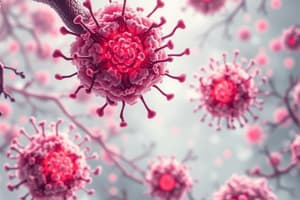Podcast
Questions and Answers
What is hypersensitivity primarily characterized by?
What is hypersensitivity primarily characterized by?
- A chronic inability to recognize antigens
- A delayed immune response to infections
- A normal immune response to harmless substances
- An exaggerated immune response to specific antigens (correct)
Which of the following best describes type 1 hypersensitivity?
Which of the following best describes type 1 hypersensitivity?
- Immediate hypersensitivity often referred to as atopy (correct)
- Hypersensitivity due to autoimmune disorders
- Delayed hypersensitivity reaction
- Non-allergic hypersensitivity response
What would typically happen when someone allergic to pet dander is exposed to it?
What would typically happen when someone allergic to pet dander is exposed to it?
- Their immune system ignores it completely
- They experience an exaggerated immune reaction (correct)
- They develop immunity to the dander
- Their immune system has a delayed response
Which of the following substances is NOT commonly associated with type 1 hypersensitivity reactions?
Which of the following substances is NOT commonly associated with type 1 hypersensitivity reactions?
Why might a person who is not allergic to pet dander not react to it?
Why might a person who is not allergic to pet dander not react to it?
What type of hypersensitivity is commonly associated with allergies to substances like pollen?
What type of hypersensitivity is commonly associated with allergies to substances like pollen?
What role do dendritic cells play in the allergic reaction process?
What role do dendritic cells play in the allergic reaction process?
Which immunoglobulin type is primarily involved in type 1 hypersensitivity reactions?
Which immunoglobulin type is primarily involved in type 1 hypersensitivity reactions?
What is one of the primary effects of histamine released by mast cells during an allergic reaction?
What is one of the primary effects of histamine released by mast cells during an allergic reaction?
What immediate physiological change occurs in blood vessels as a result of mast cell activation during an allergic reaction?
What immediate physiological change occurs in blood vessels as a result of mast cell activation during an allergic reaction?
What characterizes type IV hypersensitivity reactions?
What characterizes type IV hypersensitivity reactions?
Which of the following is a common example of type IV hypersensitivity?
Which of the following is a common example of type IV hypersensitivity?
What is a significant consequence of type II hypersensitivity reactions?
What is a significant consequence of type II hypersensitivity reactions?
What role do T-cells play in type IV hypersensitivity reactions?
What role do T-cells play in type IV hypersensitivity reactions?
What is a requirement for patients who have undergone organ transplants?
What is a requirement for patients who have undergone organ transplants?
What characterizes the immediate phase of a type 1 hypersensitivity reaction?
What characterizes the immediate phase of a type 1 hypersensitivity reaction?
What is a key feature of type III hypersensitivity reactions?
What is a key feature of type III hypersensitivity reactions?
What happens during the late phase of a type 1 hypersensitivity reaction?
What happens during the late phase of a type 1 hypersensitivity reaction?
Why is it important to monitor patients after an anaphylactic allergic reaction?
Why is it important to monitor patients after an anaphylactic allergic reaction?
What role do cytokines play in type 1 hypersensitivity reactions?
What role do cytokines play in type 1 hypersensitivity reactions?
Flashcards are hidden until you start studying
Study Notes
Hypersensitivity Overview
- Hypersensitivity is an exaggerated immune response to typically harmless substances.
- Common triggers include pet dander, dust mites, and shellfish.
- Sensitized individuals may experience severe allergic reactions such as hives and inflammation.
Types of Hypersensitivity Reactions
- Four distinct types of hypersensitivity reactions exist, each with different mechanisms and effects.
Type I Hypersensitivity (Immediate Hypersensitivity)
- Referred to as atopy or allergy.
- Involves an allergic reaction to harmless substances like pollen or pet dander.
- Activation begins when allergens are recognized by dendritic cells, which present antigens to T helper cells, prompting B cells to produce IgE antibodies.
- IgE antibodies bind to mast cells, leading to degranulation and release of histamine and other mediators.
- Immediate reaction occurs within 15-30 minutes, causing symptoms like bronchospasm, mucus secretion, and edema.
- A late phase reaction may develop 48-72 hours after exposure, characterized by sustained inflammation and symptoms.
Type II Hypersensitivity (Cytotoxic Hypersensitivity)
- Involves antibodies directed against self-antigens leading to cellular damage.
- Antibody-antigen interactions may cause complement activation, leading to tissue injury.
- Common examples include autoimmune hemolytic anemia and transfusion reactions.
Type III Hypersensitivity (Immune Complex-Mediated)
- Characterized by the formation of antibody-antigen complexes that clog blood vessels.
- These complexes can initiate inflammation and attract leukocytes, resulting in vascular damage.
- Common conditions include systemic lupus erythematosus and rheumatoid arthritis, where immune complexes deposit in tissues and lead to inflammation.
Type IV Hypersensitivity (Cell-Mediated or Delayed-Type)
- Mediated by T cells; occurs 48-72 hours post-exposure.
- Involves examples such as organ transplant rejection and contact dermatitis (e.g., poison ivy).
- Activated T cells release cytokines, triggering an inflammatory response that can damage tissues.
- This delayed reaction distinguishes it from other types of hypersensitivity.
Clinical Management Considerations
- Monitoring is crucial during allergic reactions to detect late phase symptoms, particularly after anaphylaxis.
- Organ transplant recipients often require immunosuppressants to prevent type IV hypersensitivity.### Phagocytosis and Immune Response
- Macrophages ingest invading cells through a process called phagocytosis, resulting in the internalization of the target cell.
- Upon ingestion, foreign proteins (antigens) on the invading cell are presented on the macrophage surface, transforming it into an antigen-presenting cell.
- Sometimes, the immune system misinterprets similar antigens on the body’s own cells as foreign, leading to autoimmune responses.
- Neutrophils can bind to antibodies that mistakenly target self-antigens, resulting in the recruitment of more white blood cells and inflammation.
Type II Hypersensitivity Mechanism
- Type II hypersensitivity involves inappropriate immune responses towards self-antigens, which can lead to tissue damage.
- Two main consequences of antibody involvement with self-antigens:
- Destruction of tissue coordinating a cytotoxic response.
- Alteration of tissue functionality without direct destruction.
Thyroid and Autoantibodies Example
- In cases where antibodies target thyroid-stimulating hormone (TSH) receptors, they can block or stimulate these receptors:
- Blocked receptors prevent normal hormone binding, leading to reduced thyroid hormone production.
- Stimulating receptors result in excessive thyroid hormone release, causing potential hyperthyroidism.
Myasthenia Gravis Mechanism
- Myasthenia gravis is characterized by antibodies that inhibit acetylcholine receptors at the neuromuscular junction.
- When acetylcholine cannot bind to its receptors due to blockage, muscle contraction is impaired, resulting in weakness.
Anaphylaxis Overview
- Anaphylaxis is a severe, systemic type I hypersensitivity reaction that can be life-threatening.
- Histamine release leads to widespread effects, including increased vascular permeability and bronchoconstriction.
- Systemic edema occurs as fluid leaks from blood vessels, potentially causing swelling in various tissues, including the tongue.
Treatment of Anaphylaxis
- Epinephrine administration counteracts the systemic effects of anaphylaxis:
- It relaxes bronchioles, alleviating breathing difficulties.
- It reduces vascular permeability, helping to maintain blood volume.
- It increases heart rate and stroke volume to compensate for fluid loss.
Type I Hypersensitivity Reactions
- Common allergic reactions manifest as local swelling, hives, nasal congestion, and increased mucus production due to histamine effects.
- Antihistamines, such as Benadryl, are used to mitigate allergic reactions by blocking histamine action.
Studying That Suits You
Use AI to generate personalized quizzes and flashcards to suit your learning preferences.




